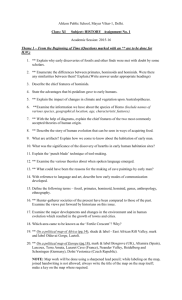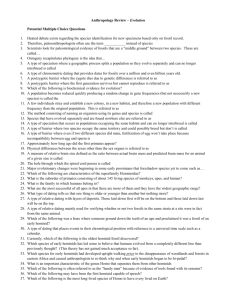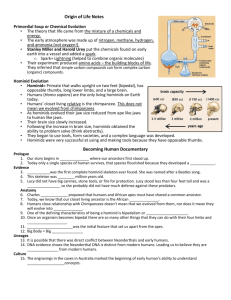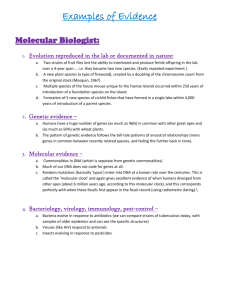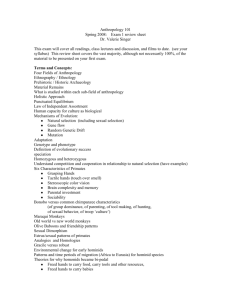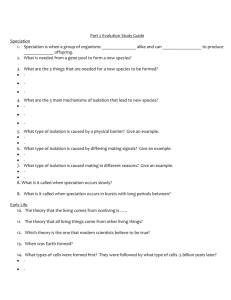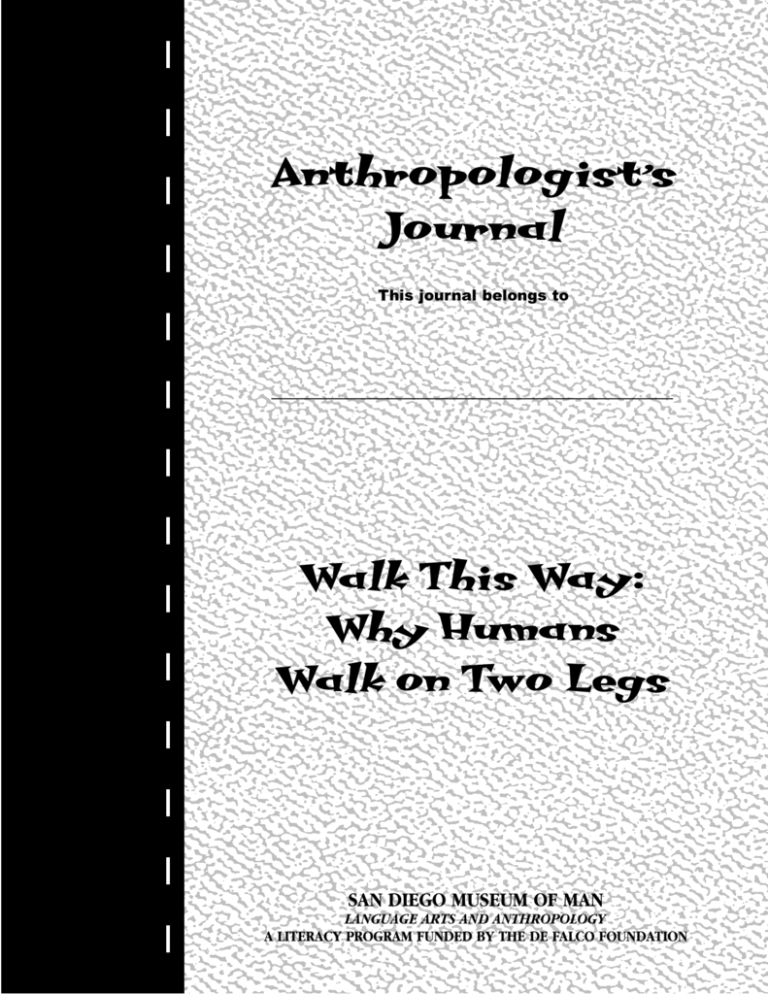
Anthropologist’s
Journal
This journal belongs to
________________________________________
Walk This Way:
Why Humans
Walk on Two Legs
San Diego Museum of Man
Language Arts and Anthropology
a Literacy program funded by the De Falco foundation
Anthropologist’s Journal
Walk This Way: Why Humans Walk on Two Legs
Introduction
Ordering the Primates
Organisms can be placed in different groups, based on similarities and
differences with other life forms. The group with the largest variety of
similar life forms is the Kingdom. As you move down the diagram below,
the groups become smaller and smaller, until you reach the group that
only has one unique type of organism—the species.
Kingdom
Animals
Plants
A Kingdom is the largest group of similar life
forms. Since animals and plants are so different
from each other, they are placed in separate
Kingdoms.
Class
Mammals
Reptiles
Birds
Amphibians
Primates
Horses
Dogs
Cats
Hominids
Apes
A Class is a smaller group within a Kingdom,
and is made of closely related Orders.
Mammals are different from other animals
since they are warm-blooded, give birth to live
offspring, and nurse their young.
Order
An Order is a group of closely related Families.
Monkeys, apes, and humans are all primates
because they are more similar to each other
than to other mammals.
Family
Monkeys
A Family is a group of closely related genera
(plural of genus). Hominids walk on two legs,
while other primates use all four limbs.
Genus
Homo
Australopithecus
A genus is a group of closely related species.
Hominids in the Homo genus used stone tools
and had bigger brains.
Species
sapiens
erectus
habilis
Each species is a unique form of life. Humans
are the only living hominid.
humans
The scientific name of each organism has the following form: Genus, species. Thus, the scientific name
for humans is Homo sapiens.
1
Anthropologist’s Journal
Walk This Way: Why Humans Walk on Two Legs
Initial Questions
How are plants and animals different?
_________________________________________________________________ _________________________________________________________________
_________________________________________________________________
_________________________________________________________________
_________________________________________________________________
_________________________________________________________________
Write the following biological categories in order from smallest to largest:
Class, species, Order, Family, Kingdom, genus.
_________________________________________________________________ _________________________________________________________________
_________________________________________________________________
_________________________________________________________________
_________________________________________________________________
_________________________________________________________________
2
Anthropologist’s Journal
Walk This Way: Why Humans Walk on Two Legs
Reading Selection 1
Primate Quadrupedalism
Even though monkeys, apes, and humans look different, they have a lot
in common. For example, all primates have grasping hands and feet.
Primates can pick up food and bring it to their mouths, and hold onto
branches as they climb through the trees. Primates also have nails instead
of claws, as well as four types of teeth: incisors, canines, pre-molars, and
molars.
All primates alive today, except for one, move using all four limbs. Arms
and legs are limbs, therefore most primates move using both their arms
and legs. Animals that walk using four limbs are quadrupedal. “Quadri”
means “four” and “ped” means “foot,” so “quadrupedal” means “fourfooted.”
Monkeys move through the trees by walking along tree branches, grasping
them with their hands and feet to make sure they don’t fall off. Sometimes
they leap from branch to branch. Some monkeys have what are called
prehensile, or grasping, tails. Having a prehensile tail means they can use
their tails to hang from tree branches, or even to pick things up.
The great apes—chimpanzees, gorillas, and orangutans—are larger than
monkeys and don’t have tails. Orangutans, who are recognizable by their
orange fur, are arboreal, which means they spend most of their time in the
trees. Since they are large (a male orangutan can weigh 200 pounds), they
climb very carefully, grasping branches with both their hands and their feet.
Sometimes they even swing from branch to branch.
When chimpanzees and gorillas walk around on the ground, they curve the
knuckles on their hands under, while keeping their feet flat. This is called
knuckle-walking, because it looks like they are walking on their knuckles.
You may have seen gorillas or chimpanzees standing up on two legs from
time to time, but they can only do that for short periods. The rest of the
time, they are walking on all four limbs.
3
Anthropologist’s Journal
Walk This Way: Why Humans Walk on Two Legs
Activity 1
Vocabulary
Write the word, used in the previous passage, next to the sentence that
describes its meaning.
___________: What primates have instead of claws.
___________________: A type of tail that can be used to pick up things or
hang from trees.
________________: The group of primates that includes chimpanzees,
gorillas, and orangutans.
_______________: To live in the trees.
_______________________: How chimpanzees and gorillas move around on
the ground.
4
Anthropologist’s Journal
Walk This Way: Why Humans Walk on Two Legs
Reading Selection 2
The Hominid Family
Maybe you’ve already guessed by now which primate uses only two limbs
to move. I’ll give you a clue: how many limbs do you use to walk? Two,
right? Most of the time anyway. Humans are the only living primates who
walk on two legs all the time. The word for walking on two legs is bipedal.
“Bi” means “two.” You already know what “ped” means.
Today, humans are the only bipedal primate. But in the past, there have
been many different species of primates that walked on two legs like
us. These bipedal primates are called hominids, and they belong to the
Hominid Family. Some hominids have scientific names like Australopithecus
afarensis, Australopithecus africanus, Homo habilis, Homo erectus, and us—
Homo sapiens. As you can tell, there are two main genera of hominids—the
Australopithecines, who have the genus name of Australopithecus, and our
genus, Homo. All hominids, other than humans, have gone
extinct, making humans the ony living representative of
the Hominid family.
So why do hominids walk on two legs, when most other
primates get along just fine walking on four? Well, part of
what happens when you only use two limbs to move is
that it frees up your hands to carry things like food from
place to place. In particular, if you need to carry food or
other items a long distance, then having your hands free
to do that is very helpful.
Even though all hominids are bipedal there are
important differences. For example not all hominids had
big brains like us. The Australopithecines were bipedal,
but had brains that were only about one-third the size
of ours.
5
Anthropologist’s Journal
Walk This Way: Why Humans Walk on Two Legs
Activity 2
Fill-in-the-blank
The following is a brief summary of the above passage. Using words from
the above reading, fill in the correct words in the passage below.
Humans are one species of bipedal primates, also known as __________.
Bipedalism probably helped hominids to _______________ food from
place to place, and to walk ______________ distances. Not all hominids
had large _______________ like us. The _________________________, an
extinct group of hominids, had brains that were about ______________ the
size of modern human brains.
Now, go back and review Reading Selection 1. Primate Quadrupedalism
Write a short summary of that section in the space below using the words
you wrote in Activity 1. Vocabulary.
_________________________________________________________________
_________________________________________________________________
_________________________________________________________________
_________________________________________________________________
_________________________________________________________________
_________________________________________________________________
_________________________________________________________________
6
Anthropologist’s Journal
Walk This Way: Why Humans Walk on Two Legs
Reading Selection 3
Bones and Bipedalism
Some of the bones of hominids, especially those in the legs and hips,
look different from the bones of other primates. In particular the upper leg
bone, the femur, and the lower leg bone, the tibia, look different—they
come together in a straight line at the knee. Think about what happens
when you walk. In the middle of each stride, one of your legs is straight.
This helps you keep your balance, plus you can use the strength in your
bones to support your weight. The knees of gorillas and chimpanzees are
always bent—they cannot straighten out their knees like we can.
(
The bones in the spine, called vertebrae, also look different. In primates
such as chimpanzees and gorillas, the spine is shaped like an upside
down smile . This shape makes sense for how they walk. In hominids,
the spine is shaped like an S—it curves in and out. This S-shape helps to
support the upper body when walking upright.
The bones in the feet are also very different. If you were
to look at the shape of a gorilla’s foot, you might think
it looked basically like a hand, and you would be right.
Gorillas can pick up things and grab onto branches
with their feet, as well as with their hands. But our feet,
just like the feet of other hominids, look very different
from
our hands. For example, our heel bone is very large,
and there is an arch between the heel and the toes.
Also, our big toe is in line with the other toes, and
does not stick out like our thumbs do. Have you ever
wondered why your big toe is so, well, big? Think about
what happens when you walk. You start by placing your
heel down, then you roll through the arch in your foot,
and the last thing to leave the ground is your big toe. So,
having a big toe helps us to walk the way we do.
Human Hand Lowland
Gorilla Hand
Human Foot Lowland
Gorilla Foot
7
Anthropologist’s Journal
Walk This Way: Why Humans Walk on Two Legs
Activity 3
Short answer
Using the information provided in the previous reading, answer the
following questions in complete sentences. Be sure to include the words
listed in parentheses in your answer.
Describe how the leg bones of hominids differ from the leg bones of other
primates. (femur, tibia, knee)
_________________________________________________________________
_________________________________________________________________
_________________________________________________________________
_________________________________________________________________
_________________________________________________________________
_________________________________________________________________
Why are our feet shaped the way they are? (big toe, heel, arch)
_________________________________________________________________ _________________________________________________________________
_________________________________________________________________
_________________________________________________________________
_________________________________________________________________
_________________________________________________________________
8
Anthropologist’s Journal
Walk This Way: Why Humans Walk on Two Legs
Other Activities
Use the bipedalism lesson plan available at the following webpage: www.
abouthumanevolution.net/html/lesson1.htm
9
Anthropologist’s Journal
Walk This Way: Why Humans Walk on Two Legs
Notes
_________________________________________________________________ _________________________________________________________________
_________________________________________________________________
_________________________________________________________________
_________________________________________________________________
_________________________________________________________________
_________________________________________________________________ _________________________________________________________________
_________________________________________________________________
_________________________________________________________________
_________________________________________________________________
_________________________________________________________________
_________________________________________________________________ _________________________________________________________________
_________________________________________________________________
_________________________________________________________________
_________________________________________________________________
_________________________________________________________________
_________________________________________________________________ 10
Anthropologist’s Journal
Walk This Way: Why Humans Walk on Two Legs
Notes
_________________________________________________________________ _________________________________________________________________
_________________________________________________________________
_________________________________________________________________
_________________________________________________________________
_________________________________________________________________
_________________________________________________________________ _________________________________________________________________
_________________________________________________________________
_________________________________________________________________
_________________________________________________________________
_________________________________________________________________
_________________________________________________________________ _________________________________________________________________
_________________________________________________________________
_________________________________________________________________
_________________________________________________________________
_________________________________________________________________
_________________________________________________________________ _________________________________________________________________
11
Anthropologist’s Journal
Walk This Way: Why Humans Walk on Two Legs
Acknowledgements
Language Arts and Anthropology: A Program for Enhancing English Literacy with
Museum of Man Education Programs was funded with a grant from the De Falco Family
Foundation, Gig Harbor, Washington, with additional support from the City of San Diego
Commission for Arts and Culture and the County of San Diego Community Enhancement
Program.
The content and educational activities included in this project were developed by the
Education Department of the San Diego Museum of Man.
San Diego Museum of Man Staff
Education Department
Project Coordinator
Kathleen Hamilton
Outreach and Tours
Eric Mason
Geralyn Hoffman
Susan Schiffer
Curator of Education
Education Coordinator
Education Specialist
Education Specialist
Anthropologist’s Journal
Editorial Content
Eric Mason
Editor
Ken Hedges
Graphic Design
Suzan Peterson
Education Coordinator
Curator of California Collections
Director of Exhibits/Design
Project Support
Administration
Executive Director
Associate Director
Accountant
Director of Development
Associate Director of Sponsored Programs
Administrative Assistant
Mari Lyn Salvador
Shirley Phillips
Lynne Fletcher
Nancy Tay
Elisa Lurkis
Denise Roy
For further information about Language Arts and Anthropology, please contact Kathleen
Hamilton, Curator of Education.
1350 El Prado • San Diego, CA 92101 • 619-239-2001 • www.museumofman.org
Copyright © 2005 San Diego Museum of Man. These materials may not be reproduced without written permission. For classroom
student use only. All rights reserved.
12

